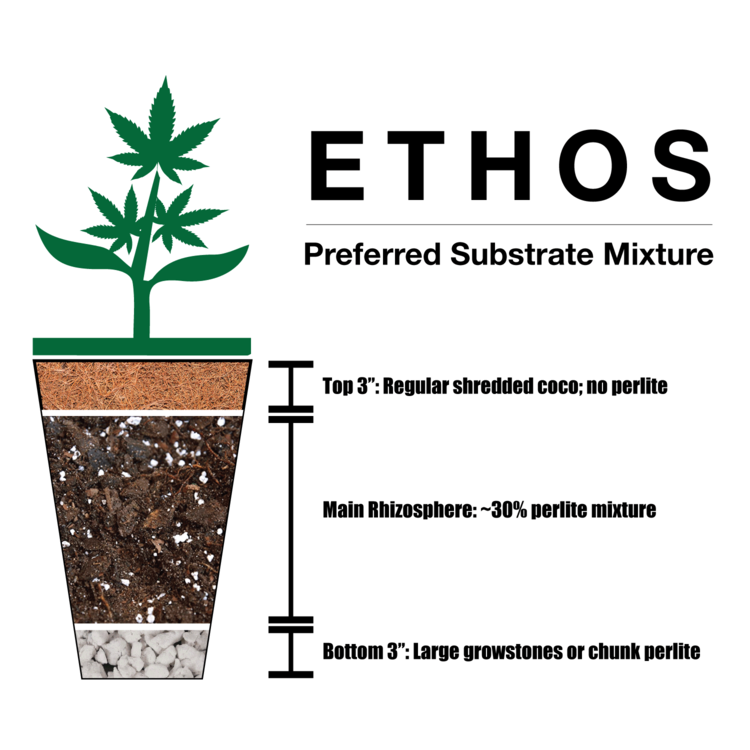Substrates 101
When configuring your grow, one of the most important decisions is choosing the right substrate for your environment and desired grow conditions. Your substrate will dictate feeding schedules, water retention, and even the physical set up of your grow space. Below you’ll find an explanation of the more common substrates, as well as a few pieces of advice and recommendations to guide your choice.
WHAT IS A SUBSTRATE?
As defined by Merriam-Webster, a substrate is the base on which an organism lives. In your garden, this translates to the growing medium that your plants are grown in. Growing mediums range in type and aeration, and include soil and soil-less options.
Substrate Types
Soil:
On a non commercial level, soil is still one of the most common growing mediums. Advanced growers may mix their own soil blends from a variety of store-bought options as well as soil conditioners such as coco perlite for added aeration. The main challenge with soil is it can get over-watered, leading to vulnerability in the rhizosphere.
Soil-less:
Sterile Soil-less: Coco is a sterile soil-less substrate with medium porosity, often cut with 30% perlite, to increase the aeration. Other options like peat are harvested and sterilized. Peat retains more moisture and uses organics with higher efficacy than coco. If you’re running an organic-dominant line, I would avoid coco and go with soil or peat. Coco and peat will need more frequent feedings than soil as they are not intended to retain as much moisture. The higher the porosity, the more frequent the feeding.
Amended Soil-less: These substrates rely on the sterile substrates discussed above in combination with organic amendments such as compost, humus or worm castings that allow for better propagation of microbes in soilless substrates, particularly with coco.
Hydroponic:
This medium is a water-based, soil-less substrate; your plant grows roots in highly-aerated water, calibrated with nutrients to maintain specific concentrations and pH levels. Hydroponic systems supports an increased metabolism and more vigorous growth with expressions like increased diameter in branches and larger fan leaves. The downside to hydroponic systems is that there is less room for error. More niche hydroponic subcategories include aeroponic and deep water culture systems, which are both fundamentally void of a substrate.
A Note on Aeration & Porosity
Cannabis plants love highly aerated, porous substrates. The increase in air circulation promotes healthy roots that can grow with little restriction, and the porosity of the substrate will determine its ability to retain moisture and nutrients for the plant’s roots to uptake. These variables affect every single substrate, regardless of what medium you’ve chosen. Higher porosity and aeration will result in faster growth and bigger plants, especially if you’re growing auto flowers which have a time-sensitive growth cycle.
In soils, a plant will be half the size (all other conditions equivalent) as it would be in an aeroponic system. Your roots have a certain amount of time to fill their space, and, in a dense rhizosphere, it takes longer to do so compared to aerated substrates. Similarly, plastic pots that retain more moisture with less aeration can have a similar effect on the substrate, and overall root growth. You want your plant to have filled its final home (final pot, final size rock wool cube, etc.) within its first few weeks of flower, but typically not beforehand. The most important criteria for sending a photoperiod plant into flower is the health and strength of its root system.
Colin's Substrate Preferences
I like coco perlite mixes, using large growstones or chunk perlite on the bottom. I use a more aerated coco perlite mixture for the bulk of the rhizosphere. For the top 3” of the container, I use just regular shredded coco, no perlite. By using shredded coco on top, I minimize evaporation, allowing for better moisture spread. This allows the roots to grow to the top of the bucket, taking advantage of the top 6” or so that typically remains underutilized as it dries out so quickly with most blends, helping to utilize the entire volume of substrate.
Additionally, while I prefer a coco perlite mixture, coco and perlite mixes dry out very easily if they are not watered multiple times a day. How often you water is really on you to decide, but I like lighter waterings, once or twice a day. In a commercial setting, I prefer an automated system that delivers 5-7 waterings each day. Worm castings or humus amendments can be added to help retain small amounts of microbials and mycorrhizae that would otherwise be lost in more aerated mediums like coco.
Regardless of substrate, your goal is to maintain static moisture throughout your container. I use a grow stone on the bottom and coco on top, which prevents compression of the coco mixture at the bottom of the container (so that it is not overly dense), and creates even moisture levels in the rhizosphere. This substrate recipe also allows me to sterilize as needed with a mixture of hydrogen peroxide and water, something unique to sterile soil-less substrates.
SUBSTRATE TAKEAWAYS
Your substrate choice will be largely dependent upon:
• How frequently you intend to water your plants.
• How aerated and porous you would like your medium to be.
• The amount of organics that you want involved with your nutrient delivery system.
• How important sterilization is.
—
Choosing the right growing medium for your specific conditions may require some trial and error and fine tuning. This process is about finding what feels right to you. Enjoy the process of discovery; it’s not about right and wrong.
